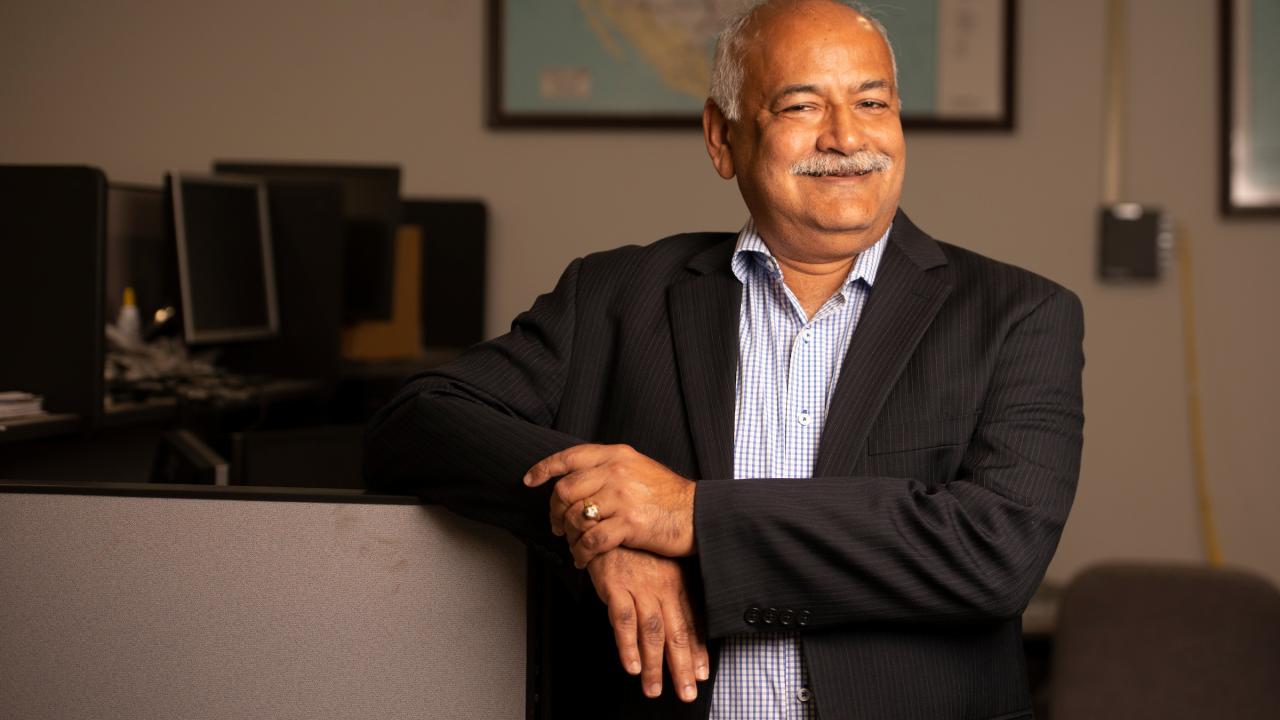AT A GLANCE
WHAT: Faculty Distinguished Research Award Lecture, presented by the Academic Senate
WHO: Biswanath Mukherjee, distinguished professor, Department of Computer Science, speaking on the topic “Rising Power of the Network User”
WHEN: noon-1 p.m. Tuesday, June 4 (sandwich lunches provided)
WHERE: Ballroom B. Activities and Recreation Center
ADMISSION: Free and open to the public; RSVPs can be arranged online and are requested by May 30
Biswanath Mukherjee, distinguished professor of computer science, delivers a distinguished lecture next week — the Faculty Distinguished Research Award Lecture — under a new format. The lecture, Tuesday, June 4, free and open to all, will be earlier in the day, from noon to 1 p.m., and sandwich lunches will be provided.
Mukherjee, a pioneer in communications network technology, has titled his address: “Rising Power of the Network User.”
The Davis Division of the Academic Senate gives no higher honor to its members than the faculty research award and its accompanying lecture opportunity. Mukherjee is the 76th recipient since 1942. “I feel very honored and lucky to be chosen,” he said.
Networks …
When Mukherjee came to UC Davis as an assistant professor in 1987, the only telephones were landlines and the internet was something for academics and scientists. But then, as now, the backbone of communication networks was made from fiber-optic cable. Bundles of hundreds of fibers, each thinner than a hair, span the globe carrying data as pulses of light. Mukherjee had studied optical networking for his Ph.D. at the University of Washington and continued working on it at UC Davis.
“The first few years I was here the things I was doing were for fun and games, but they turned out to be very, very important,” he said.
Mukherjee and Karl Levitt won a small grant from Lawrence Livermore National Laboratory to work on computer security and network security. Most of the graduate students in computer science — at the time a division of the Department of Electrical and Computer Engineering — wanted to work on computer security with Levitt, but one, Todd Heberlein, opted to work with Mukherjee on network security.
… and what they reveal
What Mukherjee and Heberlein wanted to know was, could they detect someone trying to hack into computers by looking at network traffic and anomalies?
If you want to catch a burglar, you could set alarms inside your house. But you could also look for a suspicious-looking person loitering in the street with a bag of tools.
“So by watching the traffic on the network I can figure out if someone is exploiting a vulnerability in the computer,” Mukherjee said.
Thirty years later, network intrusion detection is a $10-billion-a-year industry. “We had no idea it would become so big,” Mukherjee said. “We didn’t do patents and startups, we just wrote papers and were happy.”
1st network firewall
Mukherjee’s laboratory at UC Davis was also the first to build a “firewall” to block access to some parts of a network. Based on two network interface cards and some specially written software, the first firewall isolated Mukherjee’s lab network from the rest of the Department of Computer Science, only allowing certain traffic through.
Again, Mukherjee published the work in academic journals. Some years later, he was contacted by lawyers working for companies in dispute over who had invented the technology.
“Then they discovered my paper and they couldn’t quarrel about it anymore,” he said.
Mukherjee eventually got the startup bug, though. In 2010 he founded Ennetix Inc. (formerly Putah Green Systems). Initially, the company aimed to help companies optimize energy use on data networks but it later pivoted to network analytics.
Unwanted ‘circle of death’
“We’ve all experienced the ‘circle of death’ when we’re online. Nobody wants to see that,” Mukherjee said.
Ennetix’s products use machine learning and artificial intelligence to analyze network traffic from the user’s perspective and identify network degradation before users notice a problem.
“The amount of information on networks is growing by leaps and bounds, but the reaction time we expect is the same. So you need powerful techniques of machine learning and AI to help manage them effectively,” Mukherjee said.
About 12 years ago, Mukherjee’s lab was the first to propose seamless connection between wireless networks and the optical-fiber backbone. Now, the new 5G standard for wireless networks being adopted around the world achieves that goal.
Existing 4G wireless networks manage data well, but they are not concerned with what happens to the data once it reaches the optical backbone, Mukherjee said. He compared it to taking an international flight.
Seamless handovers in 5G
“Let’s say you’re going from Sacramento to Milan via San Francisco. So the analogy for 4G is, sure we’ll get you to San Francisco, but beyond that we don’t care. We’ll get you to San Francisco but then you have to get your luggage out and then you can go to the airline counter and get your new boarding pass and so on. That’s the state of the art now.”
In contrast, the 5G network is like being checked through to your final destination — the handover is seamless.
Mukherjee takes a long-term view of the future of networking. “Ten years out, who knows? I think we’ll definitely see more attention to the end user,” he said. “I like to look in 50- or 60-year increments.”
At the beginning of the 20th century, people were getting used to sound transmitted over telephones and radio. In the 1950s came television. Now, we seem to be on the edge of adding touch to the senses that can be transmitted as virtual reality technology improves.
“If you can convert it to bits, we’ll carry it on the network,” Mukherjee said.
Three Minute Egghead podcast: Mukherjee Celebrates the Power of the Network
Media Resources
Andy Fell, News and Media Relations, 530-752-4533, ahfell@ucdavis.edu
